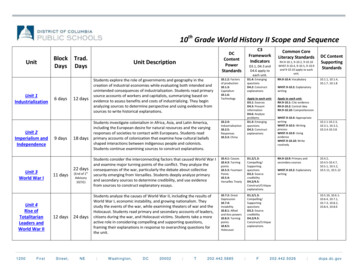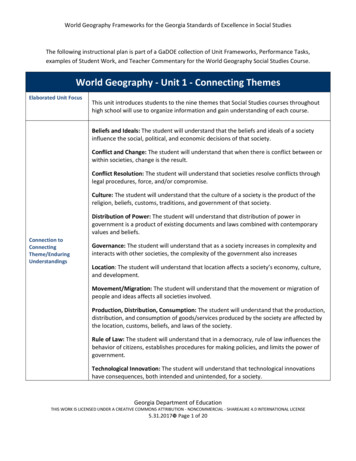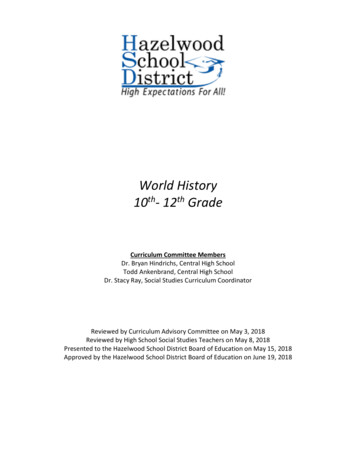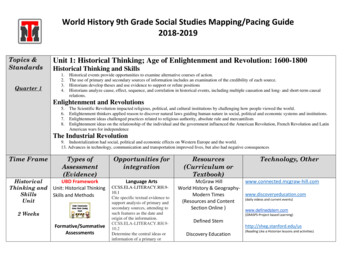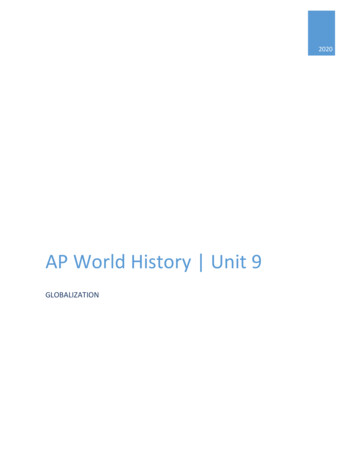
Transcription
2020AP World History Unit 9GLOBALIZATION
Source:Packed adapted from Georgia Virtual ‐ Shared Content
Lesson 1 ‐ IntroductionThe Newest Stage of World History‐ The End of Colonialism and Globalization 1950‐PresentIntroductionThe states of Latin America experienced a tremendous amount of change and economic growth during the20th century. On the other hand, the Latin American states continued to experience instability and frustrationas they struggled to find the right political and social formula. The end of World War II brought with itcircumstances that resulted in tremendous change for Japan and the Pacific Rim. Japan had begun itsmodernization and expansionism by the beginning of the 20th century and had become a major imperialisticpower by the eve of World War II. Once the Second World War was concluded Japan as a defeated powerbegan a new era of modernization and industrialization. Other less powerful states in the Pacific Rim such asKorea found themselves in a transitional mode serving as pawns in the ideological struggle between the ColdWar powers of the east and the west. The Age of the Empires came to an end as the 20th century progressed.Both World War I and World War II played a substantial role in the end of European domination of the world.Colonial territories in Africa, Asia, and the Middle East saw inherent weaknesses within the European stateswhich encouraged nationalistic leadership demanding the end of foreign domination. As the centuryprogressed and independence had been achieved by most of these territories, these newly independent statesexperienced difficulties in establishing competent governments. As they took their place in internationalpolitics new dynamics arose in maintaining international peace. The World Wars of the 20th century trulysignaled the end of a world in which one state is able to separate itself from the politics of the others. Moderntechnology, transportation, and communication made the world a much smaller place making the policy ofisolationism no longer possible and globalization a reality.
Essential Questions What effect did World War I and World War II have on the colonial relationships between theEuropean states and their territories? What social and cultural changes and/or problems developed in Japan during the 20th century? How did Japan's political system evolve between 1945 and 2004? What role did industrialization play in the development of post war Japan? To what extent were the Koreans influenced by the Japanese in the early years of the 20th century(1900‐1945)? What were the issues behind the Korean Conflict of the 1950's? Were these issues resolved? If so,how? Discuss the political, social, and economic development of Taiwan, Hong Kong, and Singapore in theyears following World War II. What role did the political development in Vietnam play in the Cold War struggle? How did the political struggles of Southeast Asia affect its artistic and cultural development? What factors led to the revolutions in Mexico, Brazil, Argentina, and Cuba? What has been the nature of the relationship between the United States and Latin America in the 20thcentury? How did the arts and culture of Latin America reflect the political, social, and economic upheaval in theregion? How did the social dynamics of Latin America shift during the 20th century? What were the processes and politics which led to the independence of India? What were the processes and politics which led to the independence of the Middle Eastern states? What were the processes and politics which led to the independence of many African states? What was the impact the newly independent Third World States have had and are still having on worldpolitics? What were the issues and problems which newly independent states have experienced in establishingor attempting to establish stable political states? What is the "new world order" which was established as a result of the newly independent nation'sdevelopment? What is "globalization" and what are its benefits and drawbacks? What international organizationspromote globalization?What to Expect Discussion: Decolonization Assignment: "Latin American Social and Cultural Movements Chart" Activity: Map Long Essay Discussion: Pacific Rim Nations Activity: Asia Map Activity: "Asia Chart" Assignment: "Asian Nationalism and Gender Roles" Assignment: DBQ Essay Activity: Globalization Activity Discussion: Globalization Project: Current Event Activity: Women as Leaders
Don't forget to read the relevant chapters in your textbook!Reading assignments from the following textbook have been included:Ways of the World for the AP Course (3rd Ed.), by Robert W. Strayer and Eric W. Nelson.In addition, the following exam preparation book is recommended for all learners:AMSCO Advanced Placement World History, by Perfection Learning, 2020 Edition.Assignment:Read pages 872‐879 in your textbook.Read pages 545‐546 and 631‐632 from your exam preparation book.Describe what you will learn in this unit after you read the pages above and review the key terms in the pages that follow.
ofWorldHistory- ‐TheEndofColonialismandGlobalization1950- ‐PresentKeyTermsBananaRepublics- ‐centralAmericangovernmentsset- ‐upbytheU.S.FulgencioBatistia- stro- NeighborPolicy- ementinLatinAmerica.“Che”Guevara- n1967.LiberationTheology- anpoor.SandinistaParty- stas- milianoZapata.GreenRevolution- ,andirrigation.F.W.deKlerk- edendApartheid.BenazirBhutto- s.AfricanNationalCongress- barak- ‐PresidentofEgyptfrom1981- erhood- pt;opposeswest.AyatollahRuhollahKhomeini- ionof1979.IndiraGandhi- an.AnwarSadat- ‐Pro- etreatywithIsrael.JawaharlalNehru- ndependenceinthe1950’s.NelsonMandela- ‐longimprisonedanti- goDinhDiem- posedbytheUS.DengXiaoping- the1960’sand1970’s.CulturalRevolution- ‐3yearcampaigninmid- munistPartyofVietnam- m’sindependence.HoChiMinh- ‐mostimportantVietnameseCommunistleader.
HongKong- econtrolin1997.GreatLeapForward- ndoned.DienBienPhu- h;gaveVietMinhcontroloverNorthVietnam.PacificRim- rmy- ‐ChineseCommunistArmy.Pragmatists- epowerfulinlate1960’s.KoreanWar- ‐1950- ‐1953- Sheavilyinvolved.VietCong- USinVietnamwar.TaysonRebellion- s;forcedgov’t.reforms.Taiwan- a.RepublicofKorea- eUSagainstNorthKorea.VietMinh- minthe1940’s;supportedbyChina.BorisYeltsin- ollapseoftheSovietUnion.Glasnost- helate1980’sintheSovietUnion.MikhailGorbachev- lapse.Pushedfor“glasnost”and“perestroika”- irstU.S.- ‐IraqWar- pationofKuwait.NAFTA- nationalCorporations- tdominateinternationaltrade.Globalization- ns,andculture.
Reading assignments from the following textbook have been included:Ways of the World for the AP Course (3rd Ed.), by Robert W. Strayer and Eric W. Nelson.In addition, the following exam preparation book is recommended for all learners:AMSCO Advanced Placement World History: Modern 1200‐Present, by Perfection Learning, 2020 Edition.Reading Assignment for this ModuleTextbook: Read from your textbook, taking notes.Lesson 1 – pages 929‐932Lesson 2 – pages 933‐937Lesson 3 – pages 938‐946Lesson 4 – pages 947‐957Lesson 5 – pages 958‐964Lesson 6 – pages 965‐973Lesson 7 – pages 975‐981Lesson 8 – pages 982‐992Lesson 9 – pages 993‐1009Lesson 10 – pages 1010‐1021Lesson 13 – pages 1023‐1035Lesson 14 – pages 1036‐1041Lesson 15 – pages 1042‐1051Lesson 16 – pages 1052‐1060Lesson 17 – pages 1061‐1072AMSCO prep book: Read from your exam preparation book, taking notes.Lesson 1 – pages 547‐553Lesson 2 – pages 554‐561Lesson 3 – pages 562‐570Lesson 4 – pages 571‐578Lesson 5 – pages 579‐588Lesson 6 – pages 589‐598Lesson 7 – pages 599‐607Lesson 8 – pages 608‐614Lesson 9 – pages 615‐622Lesson 10 – pages 623‐630Lesson 11 – pages 633‐640Lesson 12 – pages 641‐656Lesson 13 – pages 657‐666Lesson 14 – pages 667‐678Lesson 15 – pages 688‐706Lesson 16 – pages 707‐712Lesson 17 – pages 713‐721
Lesson 2: Latin America, Africa, The Middle East and China 1950‐PresentIn Latin America, the Middle East, China, and much of Africa, the 20th century witnessed a struggle between the forces of revolutionand reaction. In the second half of the 20th century, Latin America took an intermediate position between the nations of the northAtlantic and those of Africa and Asia. Investments often came from the West and Latin America was vulnerable to the world financialsystem. Throughout the 20th century, it grappled with issues of social justice, cultural autonomy, and economic security. Worker'sorganizations emerged as a political force. Explosive urban growth and emigration were often key concerns. Overall, the economyand politics were subject to broad shifts. Although much of Latin America was subject to the rhetoric of social and political change,remarkable little change actually occurred. At the same time, significant transformations took place in education, social services,women's rights and the role of industry. Deep divisions between ethnic and religious groups remained when European rulersdisappeared from their former colonies. Economic life was hampered by concessions made to the departing colonizers and by aninternational economy that favored industrialized nations. They lacked technological and management expertise, and had to facesteady population growth and environmental degradation. Social unrest occurred due to corruption, and breakdowns in traditionalculture. Failure to solve the problems produced dissent and disturbances that shook existing regimes. Opponents included politicaland religious revivalist groups with widely different proposed solutions. Leaders adopted differing strategies to remain in power, butmany were replaced by military officers who assumed dictatorial authority. In Iran, an anti‐Western religious movement triumphed.Other countries in the Middle East also struggled with decolonization and establishing stable economies and governments.Read the Latin America, Africa, the Middle East, and Asia During the 21st Century Summary as well as the "Big Picture" of LatinAmerica, the Middle East, and Asia during the 21st century, both in the pages that follow.
Visit the following websites to read more information on this unit's lesson.You will want to keep a few of your own notes as you browse these websites.Latin AmericaMexican Revolution of ��revolution‐1910The Cuban ��2136372Argentine coup d’etathttps://en.wikipedia.org/wiki/1943 Argentine coup d%27%C3%A9tatThe a National Liberation FrontChinaCondensed rican ca/features/storyofafrica/14chapter1.shtmlBritish Occupation Period in tp://i‐cias.com/e.o/nasser.htmThen, watch the Crash Course video over Decolonization: https://thecrashcourse.com/courses/worldhistory1 .You might want to keep your own notes as you watch the presentation.
21stCenturySummaryLatin America After World War II. The end of World War II was not a critical event since theregion was only modestly involved. Brazil helped the U.S. steel industry during the war and thatsector grew to compete directly with the U.S. by the 1970s. A new round of political agitationoccurred after the war. Several authoritarian regimes were challenged; one key example wasArgentina.Mexico and the PRI. Mexico continued to be controlled by the PRI but by the end of the 20thcentury its hold began to loosen. In 2000, Vicente Fox, of the PAN party, won national election.A guerrilla movement popped up in the 1990s; meanwhile the government joined NAFTA in aneffort to spur economic growth.Radical Options in the 1950s. The most important development in the decade after World WarII was a surge of radical unrest, often of a socialist nature, and the Cold War framework cameinto play. Of note were events in Bolivia, Guatemala, and Cuba.Guatemala: Reform and United States Intervention. This nation had some of the region’sworst problems, including illiteracy, poor health, and high mortality. Its economy dependedalmost exclusively on bananas and coffee. When leaders challenged the hegemony of U.S.economic interests with radical proposals, the latter nation intervened and backed a pro-U.S.regime, which rose to power. A series of military governments failed to resolve the nation'smany woes.The Cuban Revolution: Socialism in the Caribbean. Although the island had periods ofprosperity, the world market for sugar, Cuba’s main export, revealed the tenuous nature of itseconomy. A growing disparity between middle and lower economic classes underscored thenation's problems. Batista’s rule delivered little on promised reforms and opposition rose invarious sectors. One of his opponents was Fidel Castro, who pledged real democracy, justice andprosperity for all. Castro and Che Guevara gained support from many sides and overthrewBatista. Castro established collective farms, confiscated property, and set up a communist systemof repression supported by the U.S.S.R. A U.S.-sponsored intervention failed and the CubanMissile Crisis became one of the most important events of the Cold War. Since the fall ofcommunism in Europe, Cuba has become one of the last bastions of that system, but the modelof revolution and successful resistance to U.S. pressure was attractive to rebels in other LatinAmerican nations.The Search for Reform and the Military Option. A common theme in Latin America in thisera was the political influence of the Catholic church. Liberation theology combined Catholicand socialist concepts to promote change, but this system was criticized by Pope John Paul II.The church did play an important role in the fall of Paraguay's dictator in the 1980s.Out of the Barracks: Soldiers Take Power. The success of the Cuban Revolution impressedand worried those who feared revolutionary change in a communist mode. Military officers oftensaw themselves as above politics and best equipped to solve their nation's ills. Many times theseleaders had the support of the U.S. In Brazil, Argentina, Chile, Uruguay, and Peru, governments
were taken over by military-based rulers with repressive authoritarian inclinations. All theseregimes were nationalistic but approached economic problems differently; however, the resultlittle or no growth-was a common theme.The New Democratic Trends. The 1970s and 1980s witnessed an increase in democratization inmany Latin American countries, including Argentina, Brazil, Peru, Nicaragua, Guatemala, andPanama, but not without problems. Leftist rebel groups continued to agitate in some of them, asin Columbia and Peru. Cuba remained communist, but under what appeared to be fewerrestrictions. Economies continued to struggle, with inflation a common problem. Despitedifficulties, by the 1990s it appeared democratic trends were well established.The United States and Latin America: Continuing Presence. After World War I, the U.S. wasclearly the dominant power in the western hemisphere. In South America private investments byU.S. companies and loans from the government were the chief means of influence. Militaryintervention became a common means of protecting U.S. interests in Latin America—more than30 occurred before 1933—and contributed to nationalist reaction. The grounds for theseinterventions were economic, political, strategic, and ideological. The U.S. Good NeighborPolicy of the 1930s and the Alliance for Progress of the 1960s sought to ameliorate tensions. Inthe 1970s, the U.S.-built and operated Panama Canal was ceded to the Panamanian government.In 1990, that country’s dictator was overthrown by U.S. forces.In Depth: Human Rights in the 20th Century. Human rights violations in Latin America in the1960s and later mirrored actions in other parts of the world. The concept of human rights may goback to the ancient Greeks. Belief in natural law led to the protection of minorities in the 19thcentury in Europe and the United States. In the 20th century, the United Nations issued aUniversal Declaration of Human Rights, but included little power of enforcement. What seemedobvious to Western sensibilities were less so in other regions, partly because of economic and/orcultural differences. One big argument had been over what exactly constitutes human rights.Differing political ideologies place different priorities over protecting human rights and employdifferent strategies to do so.Societies in Search of Change. Societal relations changed slowly in Latin America. Women’sstatus was, however, closer to those of western Europe than Africa. There were many changes,but discrimination continues.Slow Change in Women’s Roles. Women were denied the vote until 1929 in Ecuador. By the1950s most of the region allowed female franchise. Feminist movements pushed for inclusioninto elected offices. Industrial jobs expanded to include women. Shifts in attitudes aboutwomen’s roles developed more slowly. Overall, as in many other areas, by the beginning of the21st century Latin America was in the intermediate position between industrialized anddeveloping nations where the status of women was concerned.The Movement of People. Latin America’s population soared in comparison to North America.At the beginning of the 20th century, the major population trend was immigration into LatinAmerica, but long-term trends show migration within and through the region. Illegal immigrationfrom Central America into Mexico and from Mexico into the United States was a major regional
issue. Legal migration from Haiti and Cuba because of political dissatisfaction to the U.S. wasanother big event. Rapid and massive urban growth was yet another common theme in LatinAmerica is this era; in 1999, the region was the most urbanized of the developing world.Problems related to this rapid growth remain. Nationalist and populist politics weakened theability of the working class to operate effectively in politics.Cultural Reflections of Despair and Hope. The vast majority of Latin Americans are Catholic,but Protestants are making inroads. Music and dance are important parts of popular culture andare influential world-wide. Writers gained world recognition, especially those who penned socialcriticism and/or employed “magical realism.”Global Connections: Struggling Toward the Future in a Global Economy. As Latin Americaentered the 21st century, it continued to seek economic, social and political growth and stability.New forms of politics were tried, but many long-standing problems remained. Nevertheless,Latin America was the most advanced region of the “developing” world and in the 1990s itseconomies grew considerably. Cultural issues remained unresolved and Latin America's globalposition became increasingly complex.The Challenges of Independence. Successful nationalistic movements usually involved massmobilization of peasants and urban workers drawn into national political life for the first time.Nationalist leaders promised an improved life once the Europeans departed. When thosepromises were unfulfilled, quarrels erupted among rival leaders, classes, and ethnic groups. Theresulting instability further hampered development and deflected attention from the realproblems hindering progress.The Population Bomb. Population growth proved to be one of the most important barriers toeconomic advance after independence. Importation of New World food crops had fueled growth,and colonial rule reinforced the trends by combating local war and disease. Moderntransportation systems helped to check famine. Population growth continued after independence,especially in Africa. The policies of the colonizers that limited industrial development resulted infew employment opportunities and an inability to produce necessities for rising populations.Most African and Asian nations have been slow to develop birth control programs in their maledominated societies. Procreation demonstrates male virility, while the wish for male children iscritical to female social standing. In Africa, some societies regard children as vital additions tolineage networks. High mortality rates formerly had encouraged families to have many children,a factor persisting when rates declined. Many African and Asian nations have recognized thedangers to their societies and now are running family planning programs.In Depth: Artificial Nations and the Rising Tide of Communal Strife. Internal strife and thecollapse of political systems have been common in the new Asian and African states. Onereaction in the West is to assert that former colonial peoples are unfit to rule themselves and thatmany were better off under European rule. Others called for active intervention by the West andJapan. The responses do not give enough attention to the immense obstacles confronting the newnations, or to the harmful legacies of colonial rule. Western societies in the past also had to
overcome disruptive social and political divisions. Nearly all new Asian and African states wereartificially created by Europeans who gave minimal attention to the interests of the peoplesinvolved. The imposed boundaries incorporated ethnic and religious groups that were often veryhostile. The colonial rulers maintained power by divide-and-rule tactics. When the colonial eraended, the rulers left resolution of long-existing problems to new regimes unable to containthem. Internal strife and war between states resulted, and democratic regimes suffered. Economicimprovement was hampered by military spending, while hostilities caused extensive humansuffering.Parasitic Cities and Endangered Ecosystems. Population growth contributed to massivemigration to urban areas. Most cities lacked expanding industrial sectors able to utilize thepeople who arriving, thus forming the urban underclass. They became a volatile factor in postindependence political struggles and forced governments to expend valuable resources to keepfood and other staples available and cheap. The cities spread without planning and developedvast slums. Some nations concluded that only slums could provide necessary housing, and thussupplied them with electrical and sanitary systems. The result is the creation of parasitic, notproductive, cities that diminish national resources by drawing supplies from alreadyimpoverished rural regions. The demands upon the latter have caused soil depletion anddeforestation that upset fragile tropical ecosystems. Industrial pollution heightens the problem.Women’s Subordination and the Nature of Feminist Struggles in the Postcolonial Era. Theconstitutions of the new nations promised women, who had played an active role inindependence struggles, legal, educational, and occupational equality. Post-independence realitywas different as males continued to dominate political life in African and Asian countries. Thefew important female heads of state, such as Indira Gandhi, initially won support because ofconnections to powerful males. The inferior education of most women helps to ensure theircontinuance in secondary roles. The position of women is equally disadvantageous outside thepolitical sphere. Obstacles to self-fulfillment and even survival are much greater than indemocratic or communist societies. Early marriages force many women to spend their youth andmiddle age caring for children at the expense of gaining education or following a career. Poorsanitation, lack of food, and male-centric customs endanger the lives of women and theirchildren. Where legal rights exist, the lack of education and resources often block women’schances to utilize them. The spread of religious fundamentalism usually suppresses women’sopportunities and rights.Neocolonialism, Cold War Rivalries, and Stunted Development. The plans of the leaders ofnew nations for industrial development were failures. They had very limited industrial bases tobegin with, and had little capital to stimulate progress. State revenues went to internalgovernment needs. Necessary foreign exchange came from the export of cash crops andminerals. Prices of primary products, however, have fluctuated widely, and declined in relationto the prices of manufactured goods, since World War II. The gains achieved by nationsproducing oil were temporary. Many African and Asian leaders have blamed the legacy ofcolonialism for their economic problems. Neocolonialism certainly contributes to theirdifficulties, but it is not the sole contributing factor. New nations often have fallen to corruptelites that rule at the expense of the mass of the population. Asian and African nations havesought aid from international organizations or industrial nations, but the price can be high in
economic and political concessions. When the requirement for aid was a removal of statesubsidies for food and other staple goods, regimes faced unrest or collapse.Paths to Economic Growth and Social Justice. Whatever the source of blame for lack of postindependence development, leaders of new nations had to deliver on at least some of theirpromises if they were to continue in power. Different general efforts have achieved somesuccess, but the majority of the population has rarely benefited. Often, new problems arise frompartially successful endeavors.Charismatic Populists and One-Party Rule. One of the least successful responses was thedevelopment of authoritarian rule under a charismatic leader. After 1957, Kwame Nkrumah inGhana attempted reform programs to improve the lives of Ghanaians. Internal rivals hamperedinitiatives, while Nkrumah’s turning to the Soviet bloc and its ideology drove off Westerninvestors. The price of cocoa, the dominant export crop, fell sharply in the world market.Nkrumah, despite the difficulties, went ahead with his policies. Most failed. During the 1960s, heforcibly crushed all opposition groups and took dictatorial powers. Nkrumah tried to justify hisactions by manipulating symbols supposedly drawn from Ghana's past and by talk of a uniquebrand of African socialism. As the economy floundered, opposition increased; Nkrumah wasdeposed in 1966 and died in exile in 1972.Military Responses: Dictatorships and Revolutions. There have been many military coups inAsian and African nations. The military often is one of the few societal groups resistant to ethnicand religious divisions, and it has the near monopoly of force. Soldiers may have the technicaltraining lacking among civilian leaders. When military men were anticommunist, they gainedWestern assistance. Once in power, many military men established repressive and corruptregimes where limited resources were used to protect their authority. Some leaders attackedneighbors to divert attention from their failures. A few military men were different and attemptedradical reform. Gamal Abdul Nasser took power in Egypt in 1952 as part of the Free Officersmovement, formed during the 1930s by young nationalistic officers. They were allied for a longperiod with another opponent of the regime, the Muslim Brotherhood, founded in 1928 by Hasanal-Banna, a teacher and scholar interested in scientific subjects and independence for Egypt. Hewas contemptuous of the wealthy Egyptian and European minority who flourished in the midstof general poverty. The Muslim Brotherhood was founded to remedy such problems. Althoughbelievers in fundamentalist Islam, its members worked for sweeping reforms. By
Mar 10, 2020 · Ways of the World for the AP Course (3rd Ed.), by Robert W. Strayer and Eric W. Nelson. In addition, the following exam preparation book is recommended for all learners: AMSCO Advanced Placement World History, by Perfection Learning, 2020



